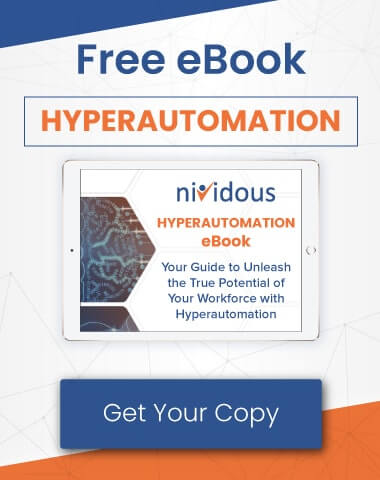For the most part, the banking industry has readily embraced technology. Large banks, in particular, have been experimenting for years with a variety of digital systems, applications, customer experience platforms, and automation, all of which are intended to do everything from improving the customer experience and simplifying compliance to streamlining workflows and more.
But is all this experimentation really indicative of a “digital transformation” in banking? Is simply embracing the latest technology tools the secret to future survival? Or is there more to it?
In our view, there is more. As an intelligent automation company, we’ve seen the incredible impact technology can have on a business, banks included. But the biggest strides are made when this technology is used intentionally and strategically to create new value propositions—something an ad-hoc approach to technology simply can’t deliver.
So what exactly is digital transformation in banking? Here’s our take on it.
Looking to make headway with your bank’s digital transformation?
Nividous can help you start small (with a single process) and think big (expand incrementally).
What is digital transformation in banking?
In our view, digital transformation means adopting a digital-first mindset, one in which the emphasis is on reframing the way your financial organization works to deliver new value propositions through leveraging technology.
A bank or other financial services organization that has undergone a digital transformation has specific characteristics:
- It seeks to use technology to maximum advantage. Employees continuously look for ways to improve processes and tools to support their efforts.
- It seeks to holistically integrate new technology solutions, bringing departments and workflows together to achieve performance gains. Digital-first organizations don’t implement technology tools based solely on the needs of a single department without first considering their impact on other departments and how it might help or hinder efforts elsewhere.
- It seeks to maximize its human capital by reducing manual human effort. For most companies, their employees are their most valuable (and costly) resource. Increasing productivity even by as little as 5% will have a significant financial impact.
- It seeks to continuously consider how to use technology to create new opportunities and forge new ways of working. It’s not about forcing tech tools into an old workflow; it’s about reinventing operations to better serve the business and its customers.
Banks and other financial institutions that have embarked on this journey have proven that the approach works. Here are a few digital transformation examples in banking that help explain the concept:
- When a leading U.S.-based mortgage company faced operational challenges with regard to efficiency, lack of transparency, and escalating costs, it looked for a way to overhaul and modernize its processes across the board. It implemented an advanced business process management (BPM) platform and intelligent RPA to automate more than 40 manual business processes, improving both visibility across its business channels and compliance. The changes ultimately led to a 40% increase in revenue.
- When a rapidly growing bank struggled with a sluggish loan disbursement process, it looked for ways to revamp the entire system to better serve its customers. Using its existing IBM BPM and the Nividous hyperautomation platform, the bank created a new, centralized loan disbursement process that was reliable and more efficient. This solution increased group loan disbursement by 20% and improved customer communication as well.
- When a stock brokerage company experienced slow turnaround times and errors in franchisee onboarding, it needed a way to improve the process and reduce human involvement at the same time. It deployed a comprehensive automation solution that seamlessly interacted with its other systems, reducing process handling time by 65% and human errors by 85%; it also increased data accuracy by 100%.
Many banks seem to be forging ahead with technology; one study showed that more than 84% of financial institutions report having already implemented robotic process automation (RPA) solutions. Are you one of them? If so, where are you in the digital transformation journey? This process is often not without bumps in the road; banks sometimes struggle to move past the experimentation phase and create a company-wide transformation strategy that will truly move them forward.
How To Start (Or Level-up) Your Own Digital Transformation
The first step in entering the world of digital transformation is to take stock of where you are now.
If you’re a small bank or a local credit union, you may not have explored automation or BPM systems in the past simply because of the cost, which can run into the millions. In fact, much of the digital transformation that has already occurred in the banking sector is among larger institutions that currently utilize a BPM system of some kind.
BPM systems are useful in that they add structure to business processes by turning them into a managed sequence of steps. Rather than relying on people to check or send emails to gather information for a task—for example, processing a claim or onboarding a new customer—the BPM system automatically directs the process forward, from one person to the next, prompting what needs to be done. Nothing gets lost; everyone knows what to do, and the process moves quickly. And because BPM systems can collect a slew of data around the process, they are excellent for reporting purposes.
Many large banks are also already utilizing RPA for discrete repetitive, manual tasks. Copying and pasting information between banking systems, sending emails, and validating customer data are all straightforward sub-tasks within processes that can easily be done by bots. Automation accelerates these processes and boosts productivity.
However, even if you’re a large bank that has made significant investments in these technologies, you could still be missing opportunities to advance a digital strategy. This “siloed” approach to automation significantly limits your results and prevents you from making a truly meaningful impact on the overall business.
To become a digital-first institution, you must explore a more disciplined approach to automation that maximizes the value of your human workers across the board.
For the banking industry, hyperautomation (or intelligent automation) is the next natural step in the digital transformation journey.
Hyperautomation & Its Role In Digital Transformation
Hyperautomation is the application of enhanced technology tools (such as computer vision, machine learning, natural language processing, and others) to a complex process to automate it from beginning to end, for purposes of reducing human effort and increasing efficiency.
Hyperautomation starts with RPA and may include BPM, but it is capable of doing much more than each of these individual tools. The addition of machine learning, computer vision, and other AI technologies makes it possible to automate and simplify a process that spans departments, employees, and tasks. The result is not a piecemeal approach to automation but a holistic vision that improves operations across the board over the long term.
An example: A bank in the very early stages of digital transformation might be using a BPM or invest in a variety of automation tools to help with individual components of a customer onboarding process. But thinking about this process from a more advanced perspective requires the bank to entirely reenvision it. Consider how it can be reimagined with hyperautomation so that:
- Employees can focus on more valuable work.
- Management gains greater insights about the process (which will ultimately be helpful to the business).
- Workflows and departments work seamlessly together to produce meaningful performance gains.
For one large organization, steps in the right direction meant shedding the six different software tools it was using for various parts of its HR processes and implementing a single hyperautomation solution to modernize and connect them all, increasing visibility into the hiring process and saving tens of thousands of dollars annually.
Taking The First Steps Toward A Digital Transformation
As in any industry, digital transformation in the banking sector can be done incrementally. Many of our clients in the banking industry came to us for help once they’d identified a pain point that was costing them business—an issue that’s clearly impacting customer service, for example. Having a specific challenge you’d like to overcome for the sake of improving your business is a great place to start.
The Nividous intelligent automation platform was designed to help companies solve process-related business challenges without requiring a massive investment or a lengthy ramp-up time. Many of the projects we work on can be delivered in about four weeks and for around $50,000—a price point that puts intelligent automation within reach of even small banks and financial institutions. Most of our customers address their most obvious challenge first and later find other ways in which automation can be helpful. We know it can be difficult to “turn the ship” toward a digital-first mindset, which is why an incremental approach tends to work best.
Nevertheless, we know it’s still a fairly big commitment. That’s why, before taking on any new client, we make sure our platform is a good fit and calculate your expected ROI should you decide to work with us.
When you contact us at Nividous, here’s what you can expect before you sign on:
- First, you’ll meet with us on a short introductory call. We’ll talk about your particular business problem to see if it’s a good fit for the Nividous platform. If it is, we’ll show you a demo of the product with a more thorough explanation of what we do.
- Then we’ll schedule a discovery session. You come to us knowing you want to fix something, but you don’t know exactly what to fix or how to do it. In the discovery session, we’ll explore with you the various processes in your company that are good candidates for hyperautomation and prioritize them according to your business goals, ease of implementation, and impact on your business. In the end, you’ll have a better idea of where to start.
- Next is the deep dive. We’ll talk to your people to better understand the identified processes and see if any technical roadblocks for automation exist. We’ll gather all the information we need to give you an actual ROI. (Note that BPM functionality is built into the Nividous platform, but if you already have a BPM system, we can use your system instead of ours. We’ve solved many business problems simply by layering our product on top of, for instance, an existing IBM BPM system.)
- Finally, we produce a proposal. We’ll calculate the cost of your current process and compare it to the cost of the new process using intelligent automation. You’ll be able to see and measure the improvements before you decide to commit.
For the banking industry, digital transformation is a necessity to stay competitive. Being strategic and finding ways to deploy AI technologies holistically and at scale are the keys to continuous improvement. If you’re ready to take the first step toward your own digital transformation (or would like to learn more about it), we encourage you to contact us today.

Is Digital Transformation Relevant for Credit Unions and Banks?
Watch the webinar to get more insights into the role that digital transformation plays in the financial services industry.





